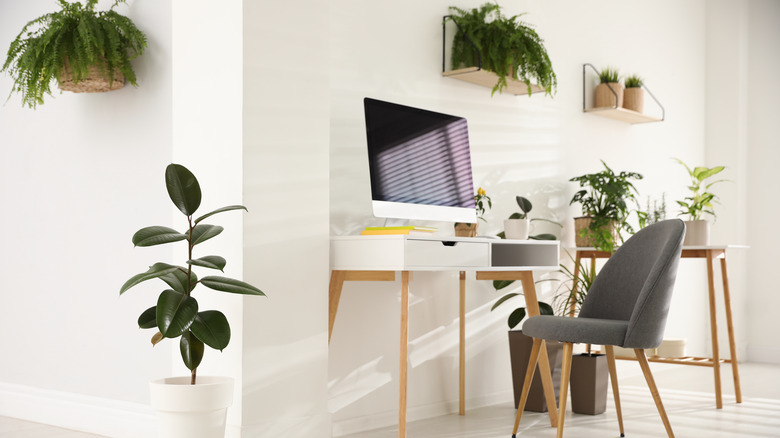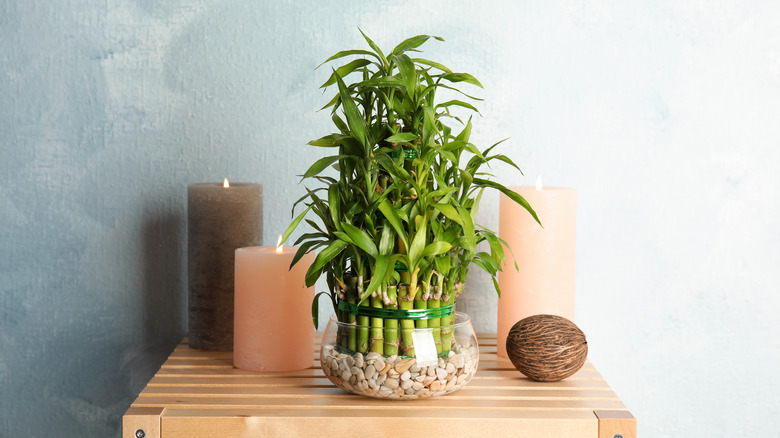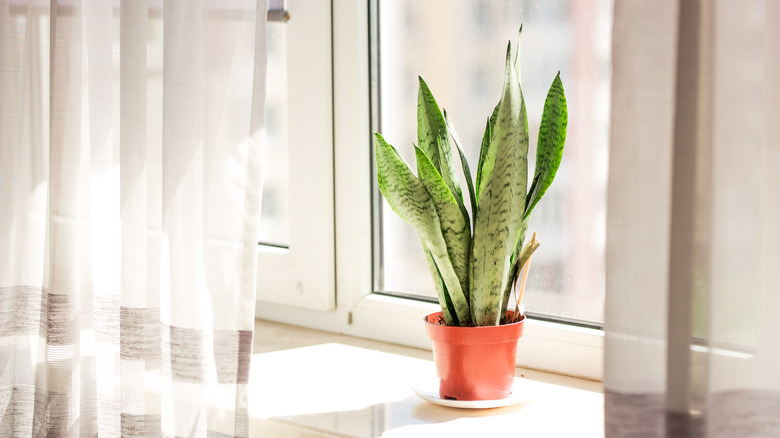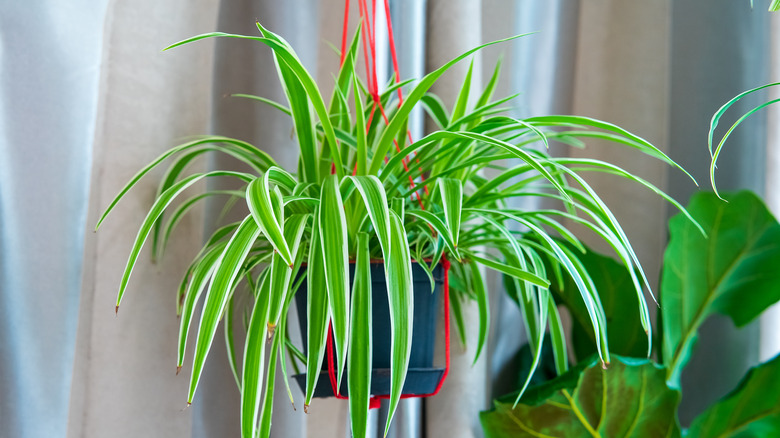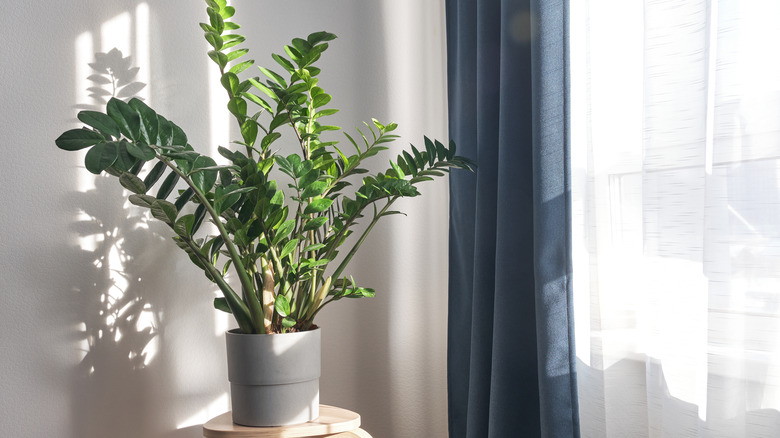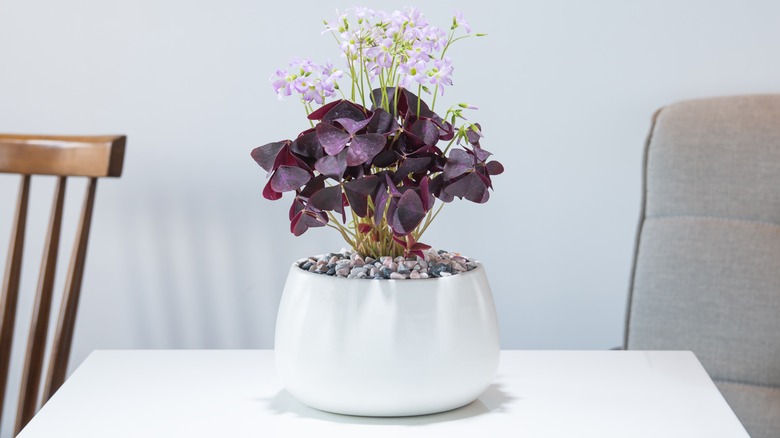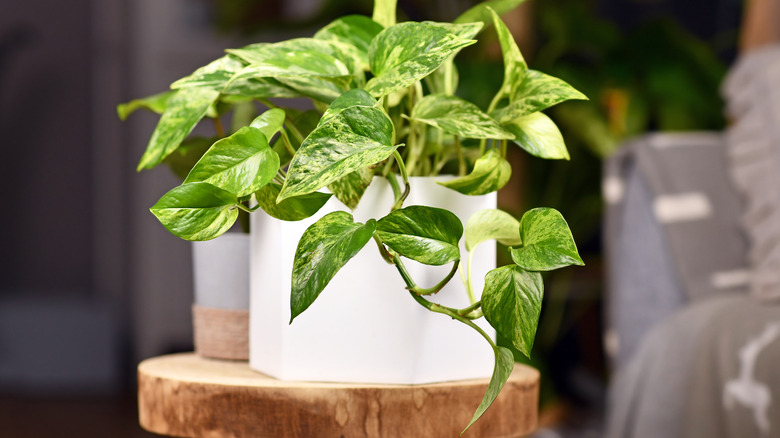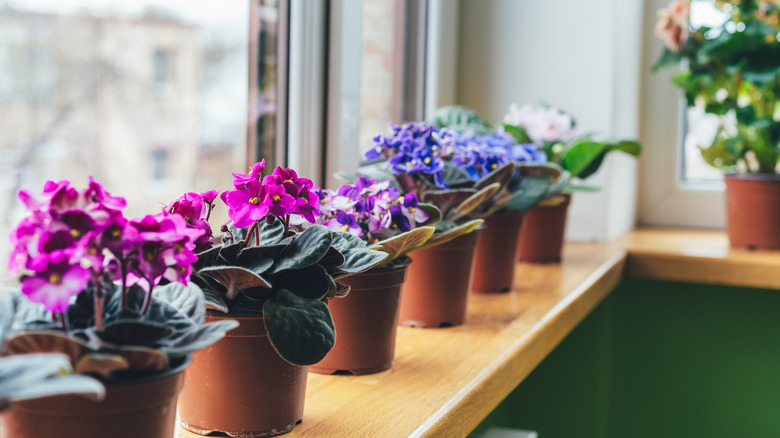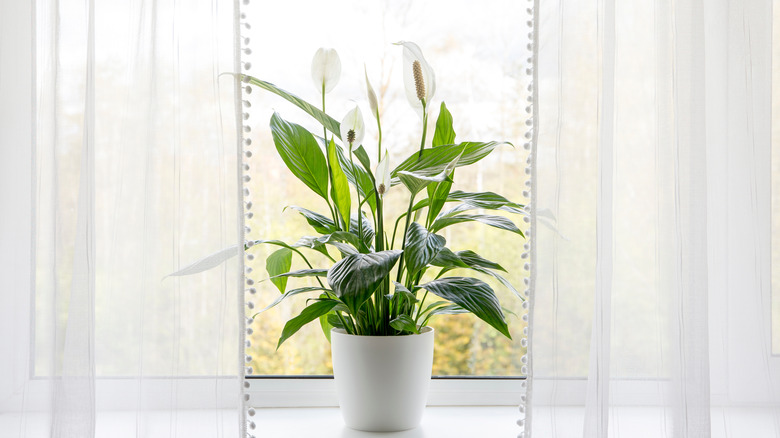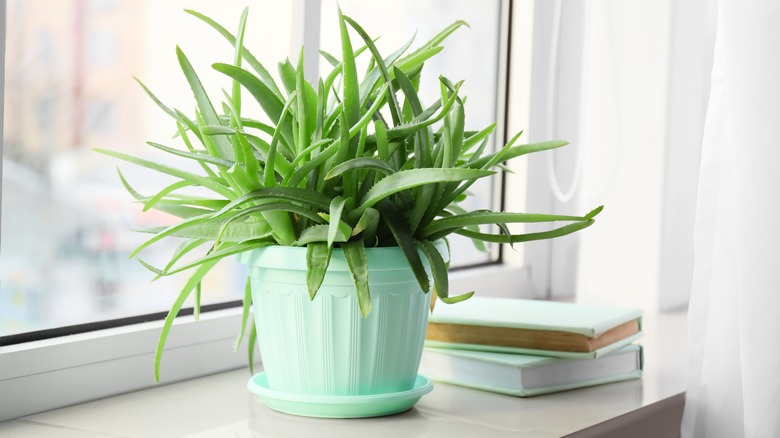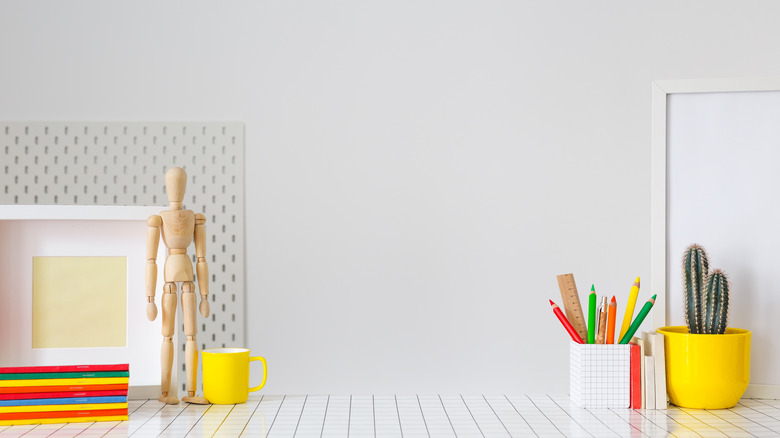The Best Plants To Spruce Up Your Home Office Atmosphere
When you're looking to liven up your home office, consider adding a few plants. In addition to bringing some color to the space, there are several other benefits associated with plants in the workplace. The American Society for Horticultural Science found having plants within eyesight of workers can help lower stress levels. Moreover, a 2014 study published in the Journal of Experimental Psychology concluded that the presence of plants in the office gave workers an improved perception of air quality, personal concentration, and overall workplace satisfaction.
Before grabbing just any plant for your home office, consider your work schedule and how easy the plant is to take care of. You don't want to commit to a high-maintenance plant if your schedule doesn't allow it or choose one that won't thrive with the available light in the space. Read on to learn more about the best plants you can add to your home office to increase its visual appeal, decrease your stress, and improve your productivity.
Lucky bamboo
If you're looking for an easy-to-care-for plant for your office, consider lucky bamboo. ProFlowers highlights some of the features of lucky bamboo that can help to make it a welcome addition to an office space. Lucky bamboo can grow in either soil or water. If you choose to grow it in soil, its watering needs are not too intense, and you'll only need to keep the soil slightly damp. If you choose to grow it in water, simply replace the water approximately once a month.
Indirect light is ideal for lucky bamboo. So, even if your office desk is away from the window, it can be a good choice for the space. It grows best in temperatures between 65 and 95 degrees Fahrenheit. According to Aire Serv Heating & Air Conditioning, keeping the thermostat set between 68 and 78 degrees Fahrenheit is best for both energy efficiency and comfort. This means that lucky bamboo should be able to grow well in your space.
Lucky bamboo is actually a member of the Dracena genus and is not really bamboo. The plant — which originated in Southeast Asia — has been used for Feng Shui for thousands of years. It is believed to offer happiness and luck to its owners. Who doesn't want a little extra luck in their workplace?
It is important to note, however, that lucky bamboo is toxic to dogs and cats. If you have furry friends in your home and office, it may not be the best plant for you to choose.
Snake plant
A snake plant is another great choice for the home office. According to Almanac, snake plants are among the easiest plants to care for. Aside from overwatering and exposure to freezing temperatures (which you shouldn't find in a home office), this plant is very resilient.
Snake plants do best in indirect light, but can also grow in low light or even some direct sunlight. This means that only infrequent watering will be needed to keep your snake plant alive and healthy. You can check to see if the plant is in need of some water by sticking a wooden stick a few inches below the soil. If the stick comes out with soil stuck to it, the plant still doesn't need to be watered.
Another great thing about snake plants is that they can grow in various lighting conditions. While indirect bright sunlight is ideal for these plants, they will also grow in lower lighting conditions (though the growth won't be quite as fast). As long as the temperature in your house is above 50 degrees Fahrenheit, the snake plant should be fine. You may want to move the plant away from draftier windows if the temperatures outside are too cold.
Spider plant
Beautify your office space with a spider plant. As Bloomscape explains, spider plants are more than just pretty plants. They can also help purify the air in a space, helping to make your office a more pleasant space to work.
A spider plant is also an excellent choice for individuals who don't have a green thumb or who are away from the office frequently. They are easy to care for and can adapt to a variety of conditions. As an example, a spider plant can grow well in different lighting conditions—from low lighting to indirect bright lighting (though an abundance of direct light might scorch the plant's leaves). Spider plants can also grow well in different humidity levels. If the air is a bit too dry for the plant, the tips of the leaves may turn brown. If this happens, you can just use a mister to keep the plant moist.
If you start with just one spider plant in your house, you may find that you soon have multiple spider plants decorating the space. When the plant is mature, it can create offshoots, called spiderettes, that can be cut off and used to create another plant. After cutting the offshoot, leave the base in a cup of water for a few weeks. Once the roots have started developing, the baby spider plant can be planted in soil.
Spider plants are non-toxic and safe for dogs and cats. They can be a great choice for those with pets that hang out in their home office.
Zamioculca zamiifolia
Also known as the ZZ plant, Zamioculca zamiifolia is often found in both home and office spaces. Plant Care Today shares more about this unique plant, along with some of its qualities that can make it a wonderful addition to a home office. Zamioculca zamiifolia is found in Eastern Africa. You may also see it referred to as the zuzu plant, the zizi plant, the Zanzibar gem, the eternity plant, the emerald plant, the steel plant, or the aroid palm.
The ZZ plant requires minimal care, so you can leave it in your home office and go about your work without paying it too much attention. It has a low water requirement and is drought tolerant, so if you really do forget about it for a while, it should be just fine. This plant can also grow in different lighting conditions, so you won't need to worry about placement or whether your home office gets enough sunlight. You could even set up a ZZ plant with a fluorescent light in a basement home office with no sunlight; they can grow really well with fluorescent light too.
Another benefit of the ZZ plant is that it doesn't have any major pest problems. Compared to other plants where you'll need to worry about pest infestation or damage, this won't be the case with the ZZ plant, making it all the easier to care for.
Oxalis
PlantMaid shares that oxalis is a low-maintenance plant. It only needs to be watered a couple of times per month, leaving you plenty of flexibility with your work or travel schedule. Oxalis does best out of the path of direct light, but in an area where it will receive bright or medium light—ideally in an east-facing window to take in the brighter morning light.
When planting oxalis, be sure to choose a deeper pot to give the plant sufficient room to grow. It is also a good idea to rotate the pot regularly for even growth. To keep it easy, you could rotate the plant every time you water it.
In addition to being easy to care for, oxalis can also add a pop of color. It has unique purple leaves that resemble a shamrock. This is why you may also hear this plant called a false shamrock or a purple shamrock.
Pothos
When you're on the hunt for the best plant for a home office, don't overlook pothos. According to The Sill, pothos can improve indoor air quality. The plant is able to remove formaldehyde and other gaseous toxins from the air.
Pothos is also relatively simple to take care of. These plants only need to be watered every one to two weeks and can grow in different lighting conditions. You'll notice the most growth if you place the plant in bright, indirect light, but if the window in your office isn't conducive to this, pothos can also grow in low to medium indirect light.
Pothos can also add some visual appeal to your office and will give you something interesting to look at while you work. It is a climbing plant — that can reach heights of up to 60 feet in the wild. While it won't grow this tall in an office, it can climb to heights between 4 and 8 inches if provided with something to grow up, such as a moss pole, and its vines can grow up to 10 feet long. This is an excellent plant to place on the top of a bookcase or on a high bookshelf, since the vines can dangle down, adding more interest to your space.
African violet
An African violet can bring cheer to an office space with its pretty blooms. Miracle-Gro shares that the blooms of African violets may be purple, pink, or white. In addition to the gorgeous flowers, the African violet also has fuzzy leaves, adding some texture and charm.
African violets can thrive in a home's climate. These plants do very well—and can live for decades—with low humidity and moderate temperatures, such as you'd find in a home office.
You'll need to be a little more purposeful with your placement of an African violet compared to some of the other low-maintenance plants shared above. The optimal space for these plants is near a south- or west-facing window. If they are placed by north- or east-facing windows, African violets should still grow, but they won't bloom well (if they bloom at all) and the leaves will be much smaller than they should be.
If you notice that your African violets start looking overgrown or too crowded in their pot, you can take cuttings and grow new plants.
Peace lily
According to Lively Root, peace lilies can grow to be between 2 and 3 feet tall and 2 and 3 feet wide, making them a good choice for those looking for a plant for their office floor. Peace lilies bloom in the spring with graceful white flowers along the tops of their spikes.
According to a NASA study, peace lilies can help reduce indoor air pollutants, like cigarette smoke and organic solvents. Peace lilies are also easy to care for. During the colder months, they only need water about every two weeks. Their water needs increase to about once a week during the warmer months. It can also help remind owners when it needs water by drooping. If you notice that your peace lily is drooping, just give it some water, and it will liven back up.
When possible, place a peace lily in a place in your office where it will receive indirect sunlight. If no such location is available, it should still grow well, but the white flowers may not grow during the spring or summer.
The Australian Animal Poisons Helpline shares that peace lilies have sharp crystals on the different parts of the plant. These crystals, called insoluble oxalates, can cause the tongue or mouth of a dog or cat to burn. Dogs or cats may also vomit, have pain when swallowing, paw at their mouth, or experience other negative symptoms after eating a peace lily. For this reason, you may want to avoid this plant if you are a pet parent.
Aloe vera
Succulents are another great option to consider when you're looking for the best plants for your home office. Specifically, you might want to add an aloe vera plant to the desk or shelf in your space. However, only choose aloe vera if there is a spot that receives plenty of bright, indirect light from the sun. As Almanac explains, you won't want to put an aloe vera plant in direct sunlight as it may cause the leaves to turn yellow due to drying the plant out.
Aloe vera prefers environments with a temperature between 55 and 80 degrees Fahrenheit, making them a good fit for the climate found in most offices.
In most cases, you'll only need to water aloe vera every two to three weeks at the most. When watering, you want to add enough to ensure that the soil is nice and moist. However, before adding new water the next time, it's best to let the top 2 inches of the soil dry most of the way. This will help prevent the roots from rotting.
Aloe vera is aesthetically pleasing with its thick, textured leaves. However, it can do more than simply enhance the appearance of your office. The juice from an aloe vera plant is actually quite useful. Applying it to burns or cuts may help alleviate pain and discomfort.
Cactus
Place a cactus in a sunny windowsill to add some character and charm to your office. According to Succulents Box, you'll want to choose a location where the cactus will get a minimum of four hours of sunlight each day for it to thrive in your office. Ideally, look for a window facing the southeast to provide the best type of light for the cactus. It is also a good idea to rotate the planter daily to ensure even sunlight and growth. If your home office doesn't offer the ideal lighting conditions, you may still be able to add a cactus to your decor. However, you'll want to opt for one that is green, as they tend to tolerate less-than-ideal lighting than brightly-colored cacti.
The water needs of this desert plant are minimal. So, even if you're away from the office for travel or are consumed by a big project for a few days, you won't need to worry about the cactus. On the flip side, it is important to make sure that you do not overwater a cactus, as it can be quite detrimental. The soil should be fully dry before new water is added.
